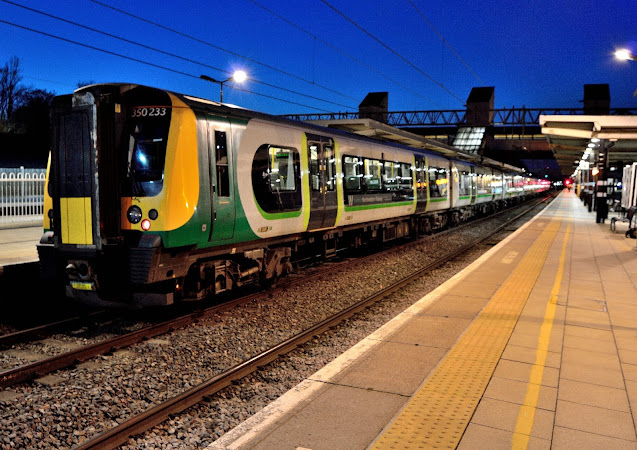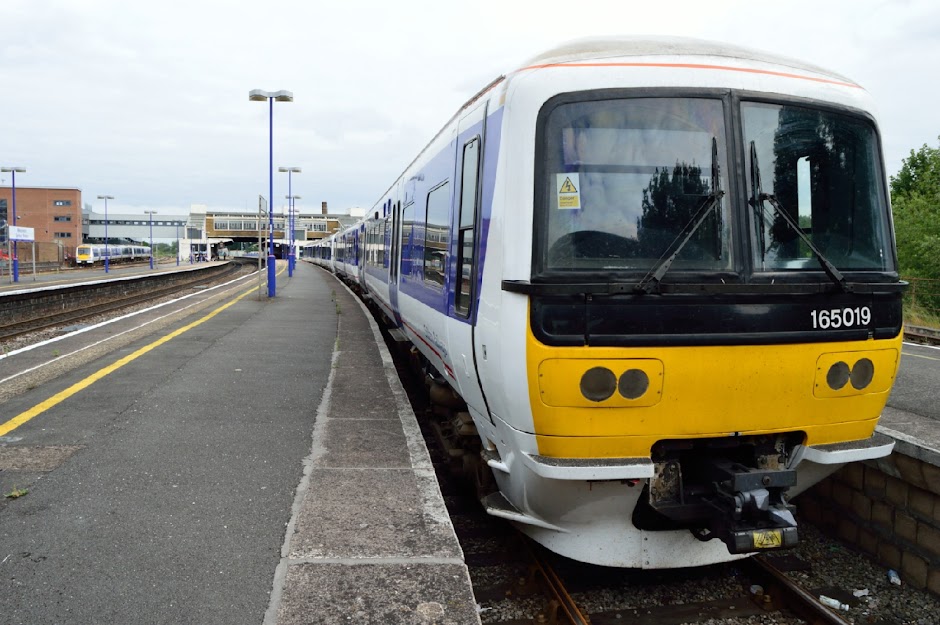London Midland Trains Class 350233 Electric Multiple Unit, Bletchley
 |
Photo: Charles Moorhen
|
The railway station of Bletchley looks deserted in this night image of 2018 as desiro 12-car London Midland Trains, Class 350 233 electric multiple unit (EMU) passenger train, waits before continuing on towards Wolverton and Northampton.
This was the last night photo, out of a total of around fifteen which, happily for me included Southern Trains Class 377701 Turbostar, I took on this particular summer night.
The West Coast Main Line station of Bletchley, once came to the public's attention for all the wrong reasons!
Video Clip - Two Class 350 EMUs Pass at Bletchley
Bletchley Train Crash - 1939
Today, as Class 66s, Class 86s and Freightliner Class 70 diesel locomotives haul long and heavy freight trains along this section of the West Coast Main Line, and Class 350 electric multiple units transport thousands of commuters into and out of London each day, and Class 390 tilting trains pass one by in the blink of an eye, it is hard to imagine that the Buckinghamshire station of Bletchley, was once the location of an horrific train crash during the early months of World War 2.
In the morning gloom of Friday the 13th October 1939, the 07:37 Euston - Inverness express train was stopped in the station (approximately where Class 350233 is standing in the photo above), whilst a shunting locomotive - a London & North Western Railway 0-8-0 Class G1 number 9168 - was attaching an extra coach to the rear.
Whilst this operation was in progress, the 07:50 Euston - Stranraer express, double-headed by two immensely powerful steam locomotives - one a 4-6-0 Royal Scot class, the other an LMS Stanier 'Black Five' No. 5025 (subsequently re-numbered 45025) - was bearing down on Bletchley station; running at high speed and three minutes behind schedule.
 |
| 'Black Five' 5025 in Preservation |
An inevitable disaster was merely seconds away.
The impact of the resulting collision was so powerful when it happened, that it lifted a number of coaches and one of the locomotives up onto the adjacent platform, a height of around 4 feet, totally demolishing the waiting and refreshment rooms.
Amid the carnage - station staff, passengers, volunteer members of the ARP unit (Air Raid Precautions) and a number of doctors offered what assistance they could to the injured, while ambulances summoned from the surrounding towns rushed to the scene.
A postman, a railway porter, an RAF serviceman and the engine driver of the G1 shunter locomotive were killed instantly. 40 other people were injured.
The more seriously injured, among them a shunter and a refreshment room waitress, were transported by road to Northampton hospital 20 miles away.
The inquiry into the cause of the crash put the blame squarely on the shoulders of the driver and fireman of the Euston to Stranraer express train. They inquiry panel cited; excessive speed and the passing of a number of track-side signals set at red as the main cause.
On a happier note: Against all the odds, one of the steam locomotives involved managed to survive the events of the 13th October 1939. 'Black Five' No. 5025 was eventually repaired and put back into mainline service. It worked for a further twenty-nine years until retirement on the 31st August 1968.
Saved from the scrapyard, it survives to this day on the preserved Strathspey Railway in Scotland.
Don't forget to subscribe to 'Along These Tracks' to get all new posts and updates sent directly to you.
Blog update:
Previous posts are now easier to find.
All blog posts are now listed alphabetically on the right side of your screen; under the heading, 'Previous Photo Posts'.
"I hope this makes your search easier".











